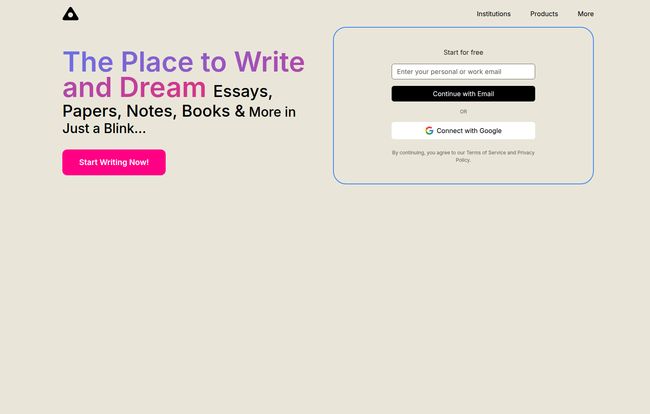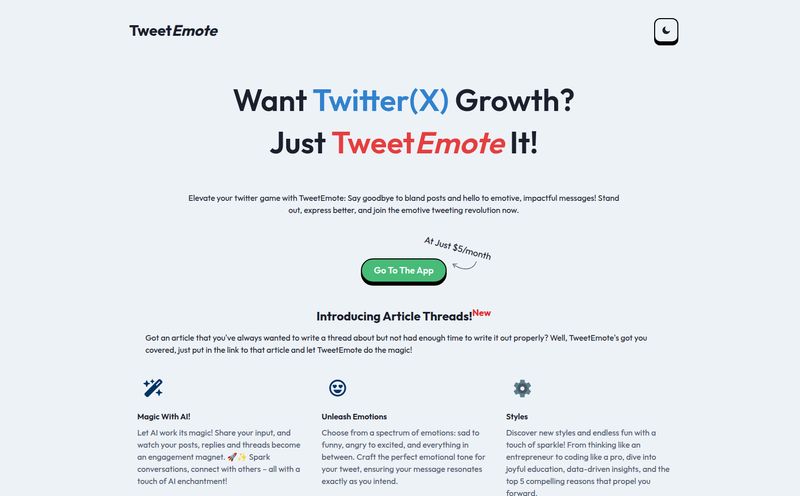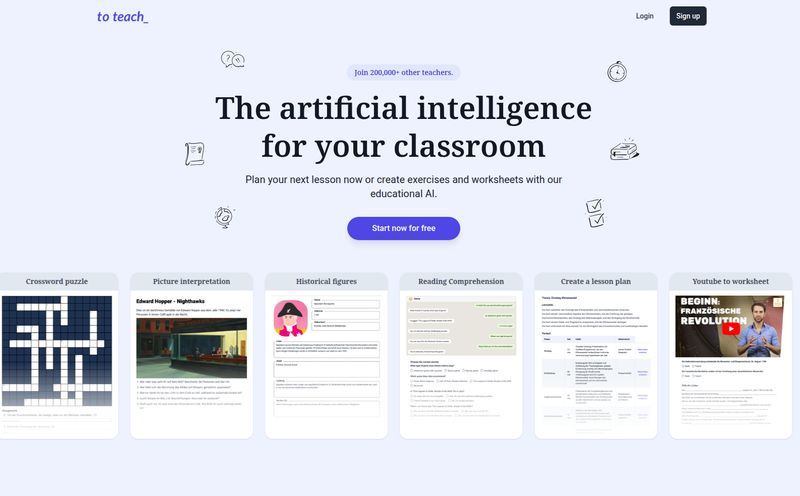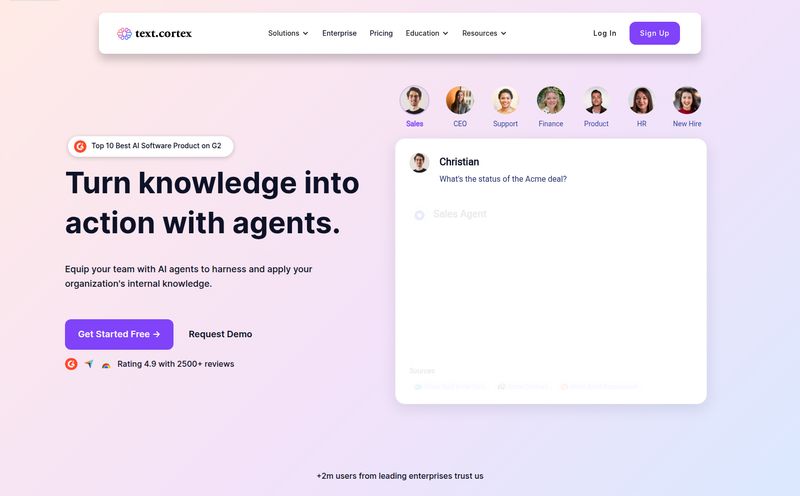If I got a dollar for every time a new AI tool landed in my inbox promising to “revolutionize my workflow,” I’d probably be retired on a beach somewhere, not hunched over a keyboard writing about them. The market is absolutely saturated. You’ve got your Jaspers, your Copy.ais, your Writesonics... the list goes on. Most of them are pretty good at churning out blog intros and social media captions. But every so often, something different pops up on my radar.
This week, it was a tool called Ag1 Labs. Their tagline? “The Place to Write and Dream.” A bit lofty, maybe, but what caught my eye was its specific focus: essays, papers, and notes. This isn’t just another general-purpose content spinner. It’s aiming squarely at the academic world. As someone who spent more years than I’d care to admit in university libraries, fueled by bad coffee and the panic of looming deadlines, my curiosity was piqued.
So, is Ag1 Labs just another drop in the AI ocean, or is it the life raft that students and researchers have been searching for? Let’s take a look.
So, What Exactly Is Ag1 Labs?
At its core, Ag1 Labs presents itself as an AI-driven text editor. Simple enough. But the magic, they claim, is in its automation. The whole idea is to take your scattered thoughts, your raw data, your half-formed arguments, and help you structure them into a coherent document. Think of it less as a ghostwriter and more as a hyper-efficient research assistant or a digital sous-chef for your brain.
It’s designed to help you build everything from a simple page of notes to a full-blown research paper, complete with references. And it does this by pulling in real-time data and using a pretty interesting-sounding feature they call an “AI consensus mechanic.” More on that in a second.

Visit Ag1 Labs
That “AI Consensus” Thing... Just a Fancy Term?
I’ve been in the SEO and digital marketing game for a long time, and I’m naturally skeptical of marketing buzzwords. “AI consensus” sounds like it could be one of them. The documentation suggests this is the system's way of rationalizing its output. I imagine it works something like this: instead of relying on a single language model’s ‘opinion,’ it might cross-reference information from multiple sources or models to find a common, logical thread. It’s like having a small panel of AI experts debate your topic and then hand you the synthesized, majority-rules summary.
If it works as advertised, this could be a huge deal for academic integrity. One of the biggest fears with using AI for schoolwork is the risk of it just… making stuff up. We've all seen the screenshots of AI confidently stating historical inaccuracies or fabricating sources. An AI that fact-checks itself against a consensus could significantly reduce those hallucinations, producing a more reliable first draft. A very big if, but a promising one.
My First Impressions: The Good, The Bad, and The AI
After poking around, I've got some thoughts. No tool is perfect, and it's always a balance of what you gain versus what you give up. Ag1 Labs is no different.
The Time-Saving Dream
Let's start with the good stuff, because there’s a lot to be excited about. The most obvious benefit is the sheer amount of time this thing could save you. The initial stages of writing a paper—the outlining, the structuring, the gathering of preliminary sources—can be an absolute slog. Automating that process is a massive win. Ag1 Labs seems built to tackle this writer's block head-on by generating a structured skeleton that you can then flesh out.
I also love the idea of personalized suggestions and real-time collaboration. Imagine working on a group project where the AI not only helps structure the document but also allows team members to jump in and edit seamlessly. That could cut down on those painful “merging three different Word documents” moments we all know and loathe. The potential to automate academic evaluations is also intriguing, though I'd want to see how that's implemented to avoid just creating a grade-chasing machine.
A Few Red Flags and Realities
Now for the other side of the coin. The biggest elephant in the room with any powerful AI tool is the danger of dependency. Will it make us lazy writers? It’s the same debate people had about calculators and mathematics. My take? It’s a tool. A hammer doesn’t build a house by itself; it just makes it a heck of a lot easier for the carpenter. You still need the critical thinking skills to guide the AI, edit its output, and add your own unique voice and analysis. If you just copy-paste, you're not learning, and you’re probably going to get a mediocre grade anyway.
Then there’s the practical stuff. The information on their data privacy and security is a bit thin. When you’re potentially inputting unpublished research or personal academic work into a platform, you want to know exactly where that data is going and how it’s being used. I'd hope the team at Ag1 Labs (based in Palo Alto, according to their site) is all over this, but more transparency would be great.
Finally, there’s the cost, which we’ll get to next.
The Million-Dollar Question About Ag1 Labs Pricing
So how much does this academic dream machine cost? Well, that's the tricky part. As of my writing this, there's no public pricing page. The site prompts you to “Start for free” by signing up with an email, which usually implies a freemium model. This means you’ll likely get some basic functionality for free, but the really powerful features—the ones we just talked about—will probably be locked behind a monthly or annual subscription.
| Potential Pricing Model | What It Might Look Like |
|---|---|
| Free Tier | Limited document creation, basic AI suggestions, maybe a word count cap. |
| Student Plan | A monthly fee (often discounted with a .edu email) for full access to features, higher usage limits. |
| Researcher/Pro Plan | Higher price for advanced collaboration, priority support, and perhaps API access. |
This is pure speculation on my part, but it's a standard SaaS playbook. For students on a tight budget, the price point will be a huge factor. I’m hoping they go with a reasonable student plan, otherwise they might price out their primary audience.
How Does It Stack Up Against the Usual Suspects?
You can’t talk about an AI writer without comparing it to the giants. So, how is Ag1 Labs different from, say, Jasper? While Jasper is an incredible all-rounder for marketing copy, blog posts, and creative writing, its academic chops aren't its main selling point. It doesn't have that built-in focus on structuring essays or managing citations.
Ag1 Labs appears to be carving out a very specific niche. It’s not trying to be everything to everyone. It’s for the student staring at a blank page with a 10-page paper on political theory due Friday. It's for the researcher trying to organize findings from a recent study. This specialized approach is its biggest strength. It’s not a Swiss Army knife; it’s a scalpel, designed for a specific, complex operation.
My Final Take: Is Ag1 Labs Worth Your Time?
So, the verdict? I’m cautiously optimistic. I think Ag1 Labs is a genuinely interesting platform that’s trying to solve a real problem for a specific audience. The academic world has its own unique set of writing challenges that general-purpose AI writers just don’t fully address.
The success of Ag1 Labs will hinge on two things: how well that “AI consensus” feature actually works to produce reliable, non-hallucinated content, and a pricing model that is accessible to its target market of students and academics. If they can nail those two things, this could easily become an indispensable tool in every student’s digital backpack.
My advice? Go sign up for the free trial. Kick the tires. See if it helps you get past that initial inertia. Just remember that it's a co-pilot, not an autopilot. You’re still the one flying the plane.
Frequently Asked Questions about Ag1 Labs
- 1. What is Ag1 Labs?
- Ag1 Labs is an AI-powered text editor specifically designed for academic writing. It helps users automate the process of creating structured documents like essays, research papers, and notes by using real-time data and an AI consensus system.
- 2. Who is the target audience for Ag1 Labs?
- The primary audience includes students, researchers, academics, and anyone involved in scholarly writing who wants to improve their productivity and streamline their writing process.
- 3. Is Ag1 Labs free to use?
- The platform offers a way to “Start for free,” which suggests a freemium model. While basic features may be free, full access to its more advanced capabilities will likely require a paid subscription.
- 4. How is Ag1 Labs different from other AI writers like Jasper or Copy.ai?
- Unlike general-purpose AI writers, Ag1 Labs is specialized for academic tasks. It focuses on document structuring, referencing, and producing rationalized output for scholarly work, rather than on marketing copy or social media content.
- 5. Is it safe to use AI for academic papers?
- It's a tool to assist, not to replace your work. It's great for brainstorming, outlining, and creating first drafts. However, you must always critically review, edit, and add your own analysis to the content. Always check your institution's policies on AI usage to avoid academic integrity issues.
- 6. What is the “AI consensus mechanic”?
- This appears to be Ag1 Labs' proprietary system for ensuring the AI's output is logical and rational. It likely involves cross-referencing information from multiple points to form a coherent and more reliable result, reducing the risk of AI “hallucinations” or fabricated information.
Reference and Sources
Official Website: Ag1 Labs
A great read on AI in education: Brookings Institution - How to responsibly harness AI in the classroom



